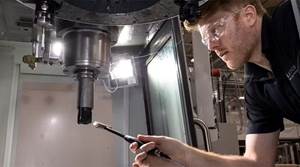Manufacturer Turns Inward for New Machine
The Hardinge Workholding Group needed a heavy-duty machine with a rigid structural design that could perform multiple operations. After scouring the market, the group found the right model closer to home than it expected.
Share





When the Hardinge Workholding Group needed a new turning center to complete the setup of a lean manufacturing cell, it didn’t have to go far. In fact, the machine it needed was being built at another Hardinge facility. The GS 200 MSY offered all the features the company considered most important: fast X- and Z-axis rapid traverse rates, high torque, a subspindle with C-axis indexing capability and sufficient rigidity and repeatability.
Related Content
How to Determine the Currently Active Work Offset Number
Determining the currently active work offset number is practical when the program zero point is changing between workpieces in a production run.
Read MoreThe Future of High Feed Milling in Modern Manufacturing
Achieve higher metal removal rates and enhanced predictability with ISCAR’s advanced high-feed milling tools — optimized for today’s competitive global market.
Read MoreHow to Mitigate Chatter to Boost Machining Rates
There are usually better solutions to chatter than just reducing the feed rate. Through vibration analysis, the chatter problem can be solved, enabling much higher metal removal rates, better quality and longer tool life.
Read More5 Tips for Running a Profitable Aerospace Shop
Aerospace machining is a demanding and competitive sector of manufacturing, but this shop demonstrates five ways to find aerospace success.
Read MoreRead Next
How I Made It: Dennis Rymanowski
Dennis Rymanowski has worked at NSH USA for 60 years, with his passion for manufacturing living alongside his passion for his family’s polka band.
Read MoreA New Frontier in Surface Finish Control
What if your machine tool could measure surface roughness as it cuts? This article explores how in-process metrology is advancing from concept to reality, enabling real-time feedback, immediate detection of anomalies and new levels of control over surface quality. Discover the technologies making this possible.
Read More


















